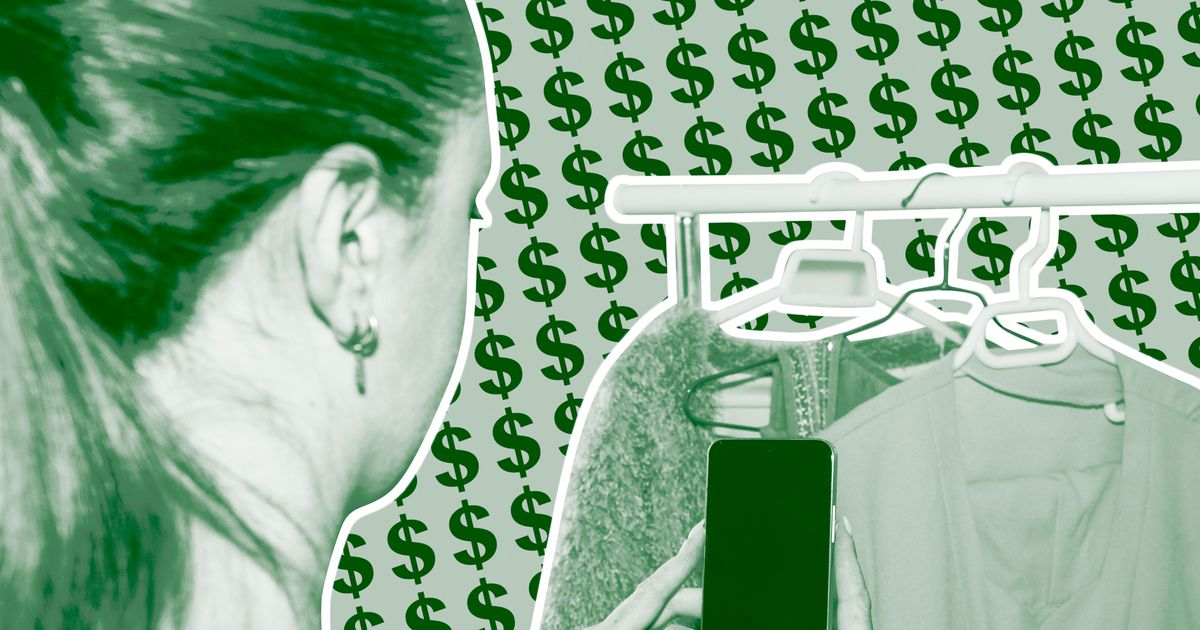
How to Resell Clothes Online, According to Experts

Photo-Illustration: by The Cut; Photo: Getty Images
You did the spring cleaning. You dumped the contents of your closet onto your bed and made your piles — the keepers, the giveaways, the nice things you could sell. Now what? Some of it is really nice! Some you’ve barely worn! Some even still has tags attached — shouldn’t you get some good money for it?
Yes, you could just ship the top-shelf items to the Real Real and the less-good stuff to ThredUp and let them do the rest for you. But if experience serves, you’ll receive a paltry $8 for your troubles. And if you really want to be annoyed, you could look up the listing and find that your pristine silk dress (with the $300 price tag still on it!) was photographed as a wrinkly wad of yellowing fabric, tossed sideways on the mannequin, priced at $40, and swiftly discounted to almost nothing. Why don’t you just sell it yourself? Surely you could do better.
If you take reselling into your own hands, it’s hard to know where to start — Poshmark? Ebay? Vestiaire? Mercari? Depop? Grailed? Etsy? Facebook Marketplace? Each offers varying services (Poshmark and Vestiaire are better known for their luxury fashion; some provide authentication in exchange for a bigger cut of the sale, etc.) And once you do choose, what’s the best way to list your items to make it worth your while without turning the venture into a whole second job? We spoke to several reselling experts to get some advice.
If you paid $300 for a dress and you’re hoping to get most of that money back by reselling it, think again. “People get very sensitive about the clothes they own,” says Veronika Shafran, the owner of Posh Consignment, a high-end consignment store based in Florida that also sells items online. “They’ll say, ‘I paid a thousand dollars for it. Why is it only $100?’ But even if you buy a Ferrari, the minute you drive it out of the dealership, it loses value. It’s the same with almost anything.”
Certain items, like bags or jewelry or luxury designer pieces, will retain more of their value on the resale market than others. “If you have a Chanel suit that you bought for $8,000, you could maybe still make $4,000 on it,” says Samantha Best, a Toronto-based stylist who has helped her clients resell their clothes online. “But if you bought something for $200, is it really worth the effort to sell it for $20 on Poshmark?” It’s important to consider the opportunity cost — you might be better off donating it (or sending it to one of the sites that will sell it for you) and spending your time on something else.
If you can see that the internet is awash with similar items that are priced lower than what you’re hoping to make, don’t bother trying to compete with them, says Best. “For example, a J.Crew blazer is going to be up against a lot of things just like it,” she explains. “Sure, maybe you paid $250 for it and wore it only twice, but it’s just not going to be worth as much as a more unique, high-end piece.” (For a more comprehensive view of what your item could be worth, the website Encore aggregates search results from hundreds of secondhand retail websites.)
Also, be honest with yourself (and others) about the condition. “Wearing something one to five times is very different from wearing it 15 to 20 times,” she says. “You might think it still looks fine, but any buyer can tell. And dealing with returns and bad reviews can be a hassle or hurt your chances of selling more things in the future.”
“Make sure the color is accurate,” says Shafran. “Don’t use any filters that could change how the color appears.” She recommends using natural light and finding a clean, white background. Include close-ups of the labels and any other details — special stitching, buttons, hardware, etc. — as well.
“I put a nail in my wall, bought a pretty gold hanger, and photograph clothes I’m reselling like I would at a boutique,” says Best. “It can also be helpful to show a photo of the same item from a retailer online, if you can find one, or take a photo of it on your body and crop out your face. There’s no such thing as too many photos.”
Some resale sites, like Vestiaire, will edit images you post so that they appear with a white background, so be mindful of how your photo will show up. If you can approximate a good flat lay picture by putting a white sheet on your floor or a table, it might be worth spending the extra three minutes to do so. And if you have it, include a photo of the tag — or even the e-receipt with your personal information cropped out.
“Always specify the designer, what collection or season it was from, and the actual name of the item because some people will search for those keywords and terms,” says Best. “For example, if it’s the Auria dress from summer 2022, include that — don’t just say ‘cotton dress.’”
“I will even take out the tape measure and specify exact inseam length and other numbers,” says Taiece Lanier, an L.A.-based stylist and creative director of Closet Editors, who sells her own clothes online regularly as well as items for her clients. “That helps potential customers feel secure in making a purchase, and it also means you won’t have to respond to a million questions from people.”
Be transparent about any defects, too, and be sure to include images of them in the photos. “If people think there might be signs of wear but they can’t see for themselves, they’re just going to keep scrolling,” says Lanier.
Other information to share, in addition to the above: the size, fit, color, material (and composition breakdown if it’s a blend); how many times it was worn; original price and approximate year of purchase. “There are a lot of shady sellers out there, and people want to know they’re dealing with a real person who’s going to be honest and professional,” Lanier adds.
Lanier often posts items she’s selling on multiple marketplaces, like Poshmark and eBay, to reach a wider audience. There are apps that will do this for you, like Vendoo; copy and paste works too. She has also found that engaging with other sellers can boost results. “Just like on social media, if you’re active, you drive more traffic to yourself,” she says. She often “likes” items that other sellers are posting, and they’ll do so in return.
“You can write in your seller profile that you respond to questions within 24 hours, or whatever time frame works for you,” says Lanier. “If you wait three days, people will usually move on. But if you set expectations, it’s more professional.” And when your item does sell, don’t delay. “Have the packaging ready so that you can ship it in a timely manner,” she says. Most resale sites will enable you to print a shipping label, so all you have to do is put it in the mail; if you communicate when you’re doing that with the customer, even better.
“It can become a third job to sell things on Poshmark or Depop,” says Best. “Set a timeline for when you want to sell it — say, three months — and after that, either donate it or give it to a friend or send it to a consignment service that will do the legwork for you.”
Remember: Sometimes the most important thing is to get rid of something you’re not using. “If you forgot you had it, or you haven’t worn it in a couple years, the most important thing is that you move on from it,” says Lanier. “Don’t get frustrated if you can’t get a lot of money for it. The space it’s taking up in your closet — or your brain — is valuable too, so it costs more to keep something than it does to simply donate it.” If she has something valuable that she can’t sell for a decent amount of money, she often gives it to Dress for Success or a friend. “I’d rather give my Gucci wallet to someone who will appreciate it than sell it for $40,” she says.
Email your money conundrums to mytwocents@nymag.com (and read our submission terms here.)
See All

